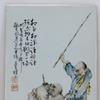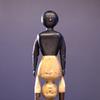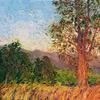View from a Hill
- February 08, 2011 05:54
Reclining under a tree, on a hill overlooking his hometown along the Hudson River, Sanford Gifford made a decision that would save his family business.
According to the story later told by his artist friend Worthington Whittredge, it would have been in the mid-1840s, perhaps summer. Sanford had taken early leave of Brown University in 1844. He didn’t want a life in business, or letters, or as his mother wished, the church. Sanford had an inclination for art.
"It was one of the greatest pleasures of my boyhood to look at and study the miscellaneous collection of engravings which covered the walls of [my older brother’s] room," he later wrote. The engravings had given Sanford an early acquaintance with Claude Lorrain, John Constable, and other artists.
After Brown University, Sanford proceeded to New York. There he took art lessons and sketched figures, with a vague and unsatisfying notion of becoming a portrait painter.
His parents, however, may still have wanted their son to choose a more regular course in life. His father managed an iron foundry and a bank in Gifford’s hometown of Hudson, New York. Even though Sanford had five brothers and five sisters, his father probably could have used his help.
Lying on the broad hilltop known as Mount Merino, Gifford gazed into the distance and thought about his options in life. Below, tiny boats plied the Hudson River. Patchwork farms quilted the countryside.
To the north, the town of Hudson lay silent along the marshy east bank of the river. Nestled among its trees were the family businesses, and if Sanford wished, a predictable and comfortable life.
Henry Ary, an artist who lived and worked in Hudson and who Gifford may already have met by then, painted a view from the top of Mount Merino in 1849. Today the painting is in the collection of the Brooklyn Museum, and it shows a view very similar to what Gifford would have seen that day.
As Sanford pondered things, according to Whittredge, "he came to the conclusion that any of the pursuits which had been suggested were good enough for him, but that he was good for nothing for any of them. This was a step forward."
Gifford’s eyes would have shifted westward across the river to the Catskill Mountains, the imaginary home of Rip Van Winkle and Natty Bumppo. He would have been well acquainted with the tales of Washington Irving and James Fenimore Cooper, and may have already explored the mountains on foot.
Below the mountains along the Hudson River he would have spied the town of Catskill, home of the landscape artist Thomas Cole. In the 1840s, despite Cole’s fame and an increasing awareness of American art among the public, a career as a landscape artist could not have held much promise.
Yet, perhaps it occurred to Gifford that the place he chose to think about his options was itself the answer.
And so, reclined in a real-life pastoral setting reminiscent of those in his brother’s Old Master engravings, Sanford made up his mind to pursue landscape art.
His father, a man of conviction but also of compassion, let his son do as he wished—perhaps thinking that, if he failed, he could always return to the fold and to the foundry.
By 1850 his father had built a new foundry in Hudson along the river. Some of Sanford's more sensible business-minded brothers and nephews went to work there, and eventually the brothers came to own it.
In late 1875, having become one of the top landscape artists in the United States, it was Sanford who was able to loan his brothers the thousands of dollars that were needed to save the foundry from bankruptcy.
Gifford explored the the Catskills, the Adirondacks, the Green and White Mountains, the Rockies, and the Alps. Yet he painted Mount Merino at least eleven times, an example of which is shown above (courtesy of Hawthorne Fine Art, LLC, New York). The little mountain loomed large in his life.
Sources:
Avery, Kevin J., and Franklin Kelly. Hudson River School Visions: The Landscapes of Sanford R. Gifford. New York: Metropolitan Museum of Art, 2003. pp. 25-29, 162-164.
Baur, John I. H., ed. The Autobiography of Worthington Whittredge, 1820-1910. New York: Arno Press, 1969. p. 56.
Weiss, Ila. Poetic Landscape: The Art and Experience of Sanford R. Gifford. Newark: University of Delaware Press, 1987. pp. 46-59, 145.






100x100_n.jpg)
100x100_c.jpg)




100x100_c.jpg)








